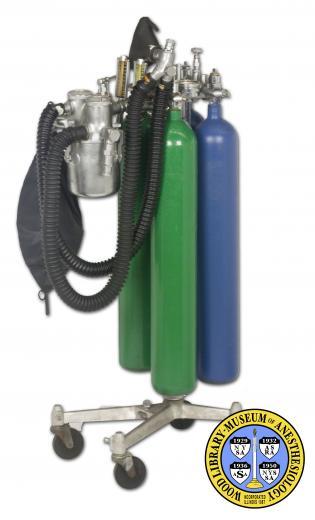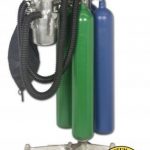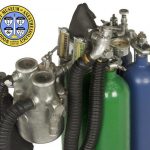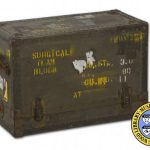Ohio 685A Military Machine
The Ohio military model was selected for use by the U. S. Army Medical Corps during World War II. Military anesthesiologists require relatively lightweight, easily transportable, and simple yet versatile equipment for use in frontline aid stations, and in full-service field hospitals. During WW II, combat zone hospitals needed to be able to change locations quickly. This prohibited the use of large and complex anesthesia machines. The anesthesia equipment also needed to withstand rough handling. This anesthesia machine could be assembled for use inside or outside of the case. Disassembled, it packed away snugly for compact and protective transport. Some anesthesiologists affectionately referred to this model as the "Pig." The Model 685 continued in service through the Korean War, and was still in use at the beginning of the Vietnam War. It was replaced by the Ohio Model 785.
Catalog Record: Ohio 685 Military Machine
Access Key: aiyf
Accession No.: 1993-13-10-1 A
Title: Ohio model 685A.
Corporate Author: Ohio Chemical & Mfg. Co.
Corporate Author: Heidbrink Co.
Title variation: Alt Title
Title: Ohio military model 685 A.
Title variation: Alt Title
Title: Heidbrink military model no. 685A.
Title variation: Alt Title
Title: Heidbrink gas anesthesia apparatus: military model no. 685A.
Title variation: Alt Title
Title: Heidbrink military model no. 685A : gas oxygen anesthesia apparatus.
Title variation: Alt Title
Title: Heidbrink “pig”.
Publisher: [Cleveland, Ohio] : Ohio Chemical & Mrg. Co., [1940-1950].
Physical Description: 1 anesthesia machine ; cast aluminum, plated brass, other metals, plastics, rubber :
96 x 25 x 50 cm.
Subject: Anesthesia Machines.
Subject: Military Medicine.
Subject: Nitrous Oxide.
Subject: Oxygen.
Subject: Ether, Ethyl.
Note Type: General
Notes: Title from markings on the head of the machine; Alternate titles based on the
WLM name for the object, an Ohio Chemical & Mfg Co. equipment catalog, and
from Zajtchuk and Grande’s Anesthesia and Perioperative Care of the Combat
Casualty.
Note Type: With
Notes: With a portable storage case and accessories; The case measures approx. 43 x
73 x 33 cm with handles; The markings on the case were printed upside-down;
The interior of the case is compartmentalized and has straps and clips for
holding the disassembled machine and its parts in place during transport.
Note Type: Citation
Notes: Zajtchuk R, Grande CM. Anesthesia and Perioperative Care of the Combat
Casualty. Washington, DC : Office of the Surgeon General, United States Army;
1995. Textbook of Military Medicine; part 4.
Note Type: Physical Description
Notes: A portable anesthesia machine assembled and out of its storage case; The base
is on four wheels, and measures approx. 15 x 28 x 43 cm; Two legs of the base
are slightly longer that the other two; The head of the machine consists of
two pairs of gas cylinder yokes; One pair is for nitrous oxide (N2O) and one
for oxygen (O2); Hanging from the N2O yoke pair, on an approx. 29 cm long
metal chain, is a wrench; The wrench is approx. 8.5 cm long; Hanging on
approx 14 cm long metal chains, from each yoke pair, is a pair of plugs, or
spacers, used to fill unused yokes; Between the two yokes for N2O is a turn
knob with a dark blue (or faded black) -colored top and “N2O” marked in
white; Between the two yokes for O2 is a turn knob with a green colored top
and “O2” marked in white; Between the two pairs of yokes are two 3000 lbs gas
gauges; The gauges’ plastic covers are discolored (a dark amber) and damaged;
When removed, the markings on the gauges are visible; One is marked for O2
and the other for N2O; Both gauges are marked with, “USE NO OIL [new line]
OHIO CHEMICAL [new line] & SURGICAL EQUIPMENT CO. [new line] A DIVISION OF
[new line] AIR REDUCTION COMPANY INCORPORATED [new line] MADISON, WISCONSIN,
U.S.A.”; Next to the O2 yoke pair is a pair of flowmeters; One of the
flowmeters is marked for N2O and the other for O2; The N2O flowmeter has a
black background with a scale marked in white; The scale on the left side of
the N2O flowmeter is graduated in “GAL. PER HOUR”, and the scale on the right
in “LITERS PER MINUTE”; The O2 flowmeter has a green background with a scale
marked in white; The scale on the left side of the O2 flowmeter is graduated
in “GAL. PER HOUR”, and the scale on the right in “LITERS PER MINUTE”;
Engraved on the machine between the two flowmeters and the O2 yokes is the
OHIO trademark followed by, “MODEL [new line] 685A”; Attached to the
flowmeter unit is a carbon dioxide (CO2) absorber; On top of the absorber is
a bypass-valve lever and pointer that can be dialed to markings in increments
of one, labeled at “OFF”, 2, 4, 6, and “FULL ON”; The face of the
bypass-valve dial is also marked with, “HEIDBRINK [new line] MADE IN U.S.A.”;
Stamped on the absorber is number “25141”; When reading the dial ‘straight
on’, the reservoir bag hangs from an extension on the left side of the CO2
absorber; The opening for attaching an ether vaporizer or connecting the
rubber tubing for gas to the patient, as well as an opening for the tube
carrying gas from the patient, are on the front of the absorber.
Note Type: Reproduction
Notes: Photographed by Mr. William Lyle, Sept. 23, 2010; In order to present an
image of the apparatus in the best state possible, this example was
photographed with gas tanks (or cylinders), rubber tubing, and an oronasal
mask from the Parts Collection; The markings on the case were printed
upside-down; So that some of the markings could be read, the case was
photographed upside-down.
Note Type: Historical
Notes: The Ohio Military Model 685 A was used during World War II. Military
anesthesiologists require relatively lightweight, easily transportable, and
simple yet versatile equipment for use in frontline aid stations, and in
full-service field hospitals. Combat zone hospitals needed to be able to
change locations quickly. This prohibited the use of large and complex
anesthesia machines. Anesthesia equipment also needed to withstand rough
handling. The company literature uses several names for this machine, or a
machine very much like it, including the “Heidbrink Military Model No. 685”.
The Heidbrink manufacturing company was acquired by Ohio Chemical &
Manufacturing by 1938. Because of its compactness, some anesthesiologists
referred to this model as the “pig” (Zajtchuk & Grande, 1995). The machine
could be assembled for use in the case or outside of the case. Disassembled,
it packed away snugly in its case for compact and protective transport.
Note Type: Acquisition
Notes: Donated to the WLM by the manufacturer Ohmeda; Donation facilitated by Dr.
Rod Calverley, Ms. Lisa Papp, and Mr. Jeff Schultz.




